4.3 Variations on Firewall Architectures
We've shown the most common firewall architectures in Figure 4.3 through Figure 4.5 . However, there is a lot of variation in architectures. There is a good deal of flexibility in how you can configure and combine firewall components to best suit your hardware, your budget, and your security policy. This section describes some common variations, and their benefits and drawbacks.
4.3.1 It's OK to Use Multiple Bastion Hosts
Although we tend to talk about a single bastion host in this book, it may make sense to use multiple bastion hosts in your firewall configuration, as we show in Figure 4.6 . Reasons you might want to do this include performance, redundancy, and the need to separate data or servers.
Figure 4.6: Architecture using two bastion hosts

You might decide to have one bastion host handle the services that are important to your own users (such as SMTP servers, proxy servers, and so on), while another host handles the services that you provide to the Internet, but which your users don't care about (for example, an anonymous FTP server). In this way, performance for your own users won't be dragged down by the activities of outside users.
You may have performance reasons to create multiple bastion hosts even if you don't provide services to the Internet. Some services, like Usenet news, are resource-intensive and easily separated from others. It's also possible to provide multiple bastion hosts with the same services for performance reasons, but it can be difficult to do load balancing. Most services need to be configured for particular servers, so creating multiple hosts for individual services works best if you can predict usage in advance.
How about redundancy? If your firewall configuration includes multiple bastion hosts, you might configure them for redundancy, so that if one fails, the services can be provided by another, but beware that only some services support this approach. For example, you might configure and designate multiple bastion hosts as DNS servers for your domain (via DNS NS [Name Server] records, which specify the name servers for a domain), or as SMTP servers (via DNS MX [Mail Exchange] records, which specify what servers will accept mail for a given host or domain), or both. Then, if one of the bastion hosts is unavailable or overloaded, the DNS and SMTP activity will use the other as a fallback system.
You might also use multiple bastion hosts to keep the data sets of services from interfering with each other. In addition to the performance issues discussed earlier, there may be security reasons for this separation. For example, you might decide to provide one HTTP server for use by your customers over the Internet, and another for use by the general public. By providing two servers, you can offer different data to customers and possibly better performance, by using a less loaded or more powerful machine.
You could also run your HTTP server and your anonymous FTP server on separate machines, to eliminate the possibility that one server could be used to compromise the other. (For a discussion of of how this might be done, see the description of HTTP server vulnerabilities in Chapter 8 .)
4.3.2 It's OK to Merge the Interior Router and the Exterior Router
You can merge the interior and exterior routers into a single router, but only if you have a router sufficiently capable and flexible. In general, you need a router that allows you to specify both inbound and outbound filters on each interface. In Chapter 6 , we discuss what this means, and we describe the packet filtering problems that may arise with routers that have more than two interfaces and don't have this capability.
If you merge the interior and exterior routers, as we show in Figure 4.7 , you'll still have a perimeter net (on one interface of the router) and a connection to your internal net (on another interface of the router). Some traffic would flow directly between the internal net and the Internet (the traffic that is permitted by the packet filtering rules set up for the router), and other traffic would flow between the perimeter net and the Internet, or the perimeter net and the internal net (the traffic that is handled by proxies).
Figure 4.7: Architecture using a merged interior and exterior router
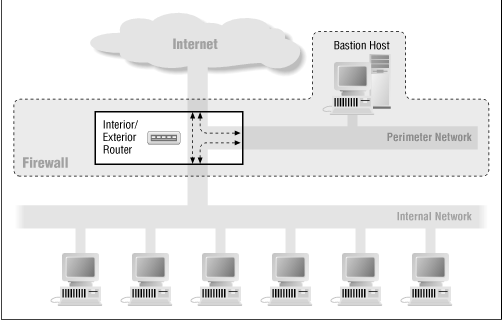
This architecture, like the screened host architecture, makes the site vulnerable to the compromise of a single router. In general, routers are easier to protect than hosts, but they are not impenetrable.
4.3.3 It's OK to Merge the Bastion Host and the Exterior Router
There might be cases in which you use a single dual-homed machine as both your bastion host and your exterior router. Here's an example: suppose you only have a dial-up SLIP or PPP connection to the Internet. In this case, you might run something like the Morning Star PPP package on your bastion host, and let it act as both bastion host and exterior router. This is functionally equivalent to the three-machine configuration (bastion host, interior router, exterior router) described for the screened subnet architecture shown earlier in this chapter.
Using a dual-homed host to route traffic won't give you the performance or the flexibility of a dedicated router, but you don't need much of either for a single low-bandwidth connection. Depending on the operating system and software you're using, you may or may not have the ability to do packet filtering. Several of the available interface software packages, such as the Morning Star PPP package mentioned earlier, have quite good packet filtering capabilities. However, because the exterior router doesn't have to do much packet filtering anyway, using an interface package that doesn't have good packet filtering capabilities is not that big a problem.
Unlike merging the interior and exterior routers, merging the bastion host with the exterior router, as shown in Figure 4.8 , does not open significant new vulnerabilities. It does expose the bastion host further. In this architecture, the bastion host is more exposed to the Internet, protected only by whatever filtering (if any) its own interface package does, and you will need to take extra care to protect it.
Figure 4.8: Architecture using a merged bastion host and exterior router

4.3.4 It's Dangerous to Merge the Bastion Host and the Interior Router
While it is acceptable to merge the bastion host and the exterior router, as we discussed in the previous section, it's not a good idea to merge the bastion host and the interior router, as we show in Figure 4.9 . Doing so compromises your overall security.
The bastion host and the exterior router each perform distinct protective tasks; they complement each other but don't back each other up. The interior router functions in part as a backup to the two of them.
If you merge the bastion host and the interior router, you've changed the firewall configuration in a fundamental way. In the first case (with a separate bastion host and interior router), you have a screened subnet firewall architecture. With this type of configuration, the perimeter net for the bastion host doesn't carry any strictly internal traffic, so this traffic is protected from snooping even if the bastion host is successfully penetrated; to get at the internal network, the attacker still must get past the interior router. In the second case (with a merged bastion host and interior router), you have a screened host firewall architecture. With this type of configuration, if the bastion host is broken into, there's nothing left in the way of security between the bastion host and the internal network.
Figure 4.9: Architecture using a merged bastion host and interior router
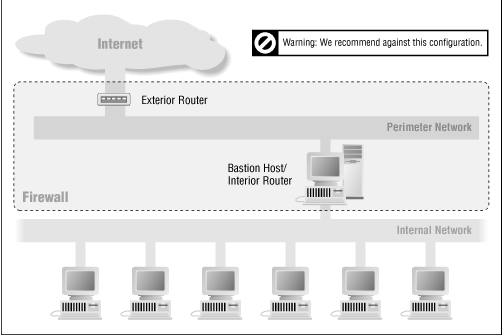
One of the main purposes of the perimeter network is to prevent the bastion host from being able to snoop on internal traffic. Moving the bastion host to the interior router makes all of your internal traffic visible to it.
4.3.5 It's Dangerous to Use Multiple Interior Routers
Using multiple interior routers to connect your perimeter net to multiple parts of your internal net can cause a lot of problems, and is generally a bad idea.
The basic problem is that the routing software on an internal system could decide that the fastest way to another internal system is via the perimeter net. If you're lucky, this approach simply won't work, because it will be blocked by the packet filtering on one of the routers. If you're unlucky, it will work, and you'll have sensitive, strictly internal traffic flowing across your perimeter net, where it can be snooped on if somebody has managed to break in to the bastion host.
It's also difficult to keep multiple interior routers correctly configured. The interior router is the one with the most important and the most complex set of packet filters and having two of them doubles your chances of getting the rule sets wrong.
Nevertheless, you may still end up wanting to do this. On a large internal network, having a single interior router may be both a performance problem and a reliability problem. If you're trying to provide redundancy, that single point of failure is a major annoyance. In that case, the safest (and most redundant) thing to do is to set up each interior router to a separate perimeter net and exterior router; this configuration is discussed later in this chapter. This configuration is more complex and more expensive, but it increases both redundancy and performance, as well as making it highly unlikely that traffic will try to go between the interior routers (if the Internet is the shortest route between two parts of your internal network, you have much worse problems than most sites) and extraordinarily unlikely that it will succeed (four sets of packet filters are trying to keep it out).
If performance problems alone are motivating you to look at multiple interior routers, it's hard to justify the expense of separate perimeter networks and exterior routers. In most cases, however, the interior router is not the performance bottleneck. If it is, then one of the following cases is occurring:
-
There is a lot of traffic going to the perimeter net that is not then going to the external network.
-
Your exterior gateway is much faster than your interior gateway.
In the first case, you have misconfigured something; the perimeter net may take occasional traffic that isn't destined for the external world in some configurations (for example, DNS queries about external hosts when the information is cached), but that traffic should never be significant. In the second case, you should seriously consider upgrading the interior router to match the exterior router, instead of adding a second one.
Figure 4.10 shows the basic architecture using multiple interior routers.
Figure 4.10: Architecture using multiple interior routers
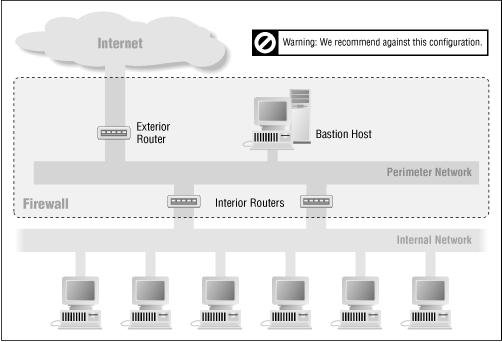
Another reason for having multiple interior routers is that you have multiple internal networks, which have technical, organizational, or political reasons not to share a single router. The simplest way to accommodate these networks would be to give them separate interfaces on a single router, as shown in Figure 4.11 . This complicates the router configuration considerably (how considerably depends a great deal on the router in question, as discussed in Chapter 6 ), but doesn't produce the risks of a multiple interior router configuration. If there are too many networks for a single router, or if sharing a router is unpalatable for other reasons, consider making an internal backbone and connecting it to the perimeter network with a single router, as shown in Figure 4.12 .
Figure 4.11: Multiple internal networks (separate interfaces in a single router)
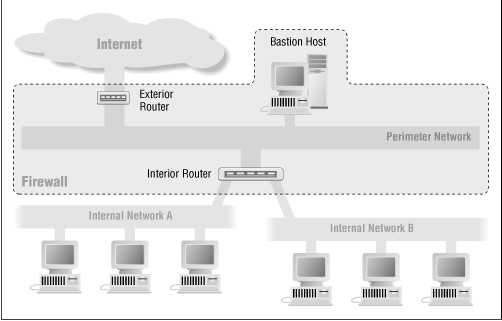
Figure 4.12: Multiple internal networks (backbone architecture)
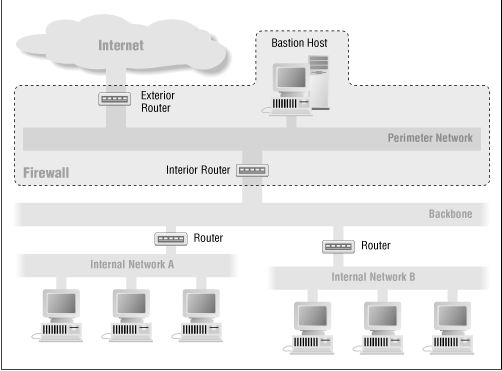
You may find that an effective way to accommodate different security policies among different internal networks is to attach them to the perimeter through separate routers, (e.g., one network wants to allow connections that others consider insecure.) In this case, the perimeter network should be the only interconnection between the internal networks; there should be no confidential traffic passing between them; and each internal network should treat the other as an untrusted, external network. This is likely to be extremely inconvenient for some users on each network, but anything else will either compromise the security of the site as a whole or remove the distinction that caused you to set up the two routers in the first place.
If you decide that you are willing to accept the risks of having multiple interior routers, you can minimize those risks by having all the interior routers managed by the same group (so conflicting security policies aren't being enforced). You should also keep a careful watch for internal traffic crossing the perimeter network and act promptly to cure the sources of it.
4.3.6 It's OK to Use Multiple Exterior Routers
There are some cases in which it makes sense to connect multiple exterior routers to the same perimeter net, as we show in Figure 4.13 .
Figure 4.13: Architecture using multiple exterior routers

Examples are:
-
You have multiple connections to the Internet (for example, through different service providers, for redundancy).
-
You have a connection to the Internet plus other connections to other sites.
In these cases, you might instead have one exterior router with multiple exterior network interfaces.
Attaching multiple exterior routers which go to the same external network (e.g., two different Internet providers) is not a significant security problem. They may have different filter sets, but that's not critical in exterior routers. There is twice the chance that one will be compromisable, but a compromise of an exterior router is not particularly threatening.
Things are more complex if the connections are to different places (for example, one is to the Internet and one is to a site you're collaborating with and need more bandwidth to). To figure out whether such an architecture makes sense in these cases, ask yourself this question: what traffic could someone see if they broke into a bastion host on this perimeter net? For example, if an attacker broke in, could he snoop on sensitive traffic between your site and a subsidiary or affiliate? If so, then you may want to think about installing multiple perimeter nets instead of multiple exterior routers on a single perimeter net. (This case is shown in the next section.)
There are other significant problems involved in setting up connections to external networks with which you have special relationships, which are discussed later in this chapter, in the section called "Internal Firewalls."
4.3.7 It's OK to Have Multiple Perimeter Networks
As we've mentioned above, you'll find in certain situations that it makes sense for your configuration to include multiple perimeter networks. Figure 4.14 shows this configuration.
Figure 4.14: Architecture using multiple perimeter nets (multiple firewalls)
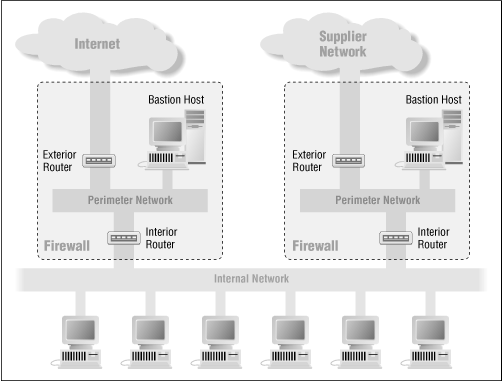
You might put in multiple perimeter nets to provide redundancy. It doesn't make much sense to pay for two connections to the Internet, and then run them both through the same router or routers. Putting in two exterior routers, two perimeter nets, and two interior routers ensures that there is no single point of failure between you and the Internet.[4]
[4] Providing, of course, that your two Internet providers are actually running on different pieces of cable, in different conduits. Never underestimate the destructive power of a backhoe.
You might also put in multiple perimeter nets for privacy, so that you can run moderately confidential data across one, and an Internet connection across the other. In that case, you might even attach both perimeter nets to the same interior router.
Having multiple perimeter nets is less risky than having multiple interior routers sharing the same internal net, but it's still a maintenance headache. You will probably have multiple interior routers, presenting multiple possible points of compromise. Those routers must be watched very carefully to keep them enforcing appropriate security policies; if they both connect to the Internet, they need to enforce the same policy.
4.3.8 It's OK to Use Dual-Homed Hosts and Screened Subnets
You can get significant increases in security by combining a dual-homed host architecture with a screened subnet architecture. To do this, split the perimeter network and insert a dual-homed host. The routers provide protection from forgery, and protect from failures where the dual-homed host starts to route traffic. The dual-homed host provides finer controls on the connections than packet filtering. This is a belt-and-suspenders firewall, providing excellent multilayered protection, although it requires careful configuration on the dual-homed host to be sure you're taking full advantage of the possibilities. (There's no point in running simple, straight-through proxies.)




